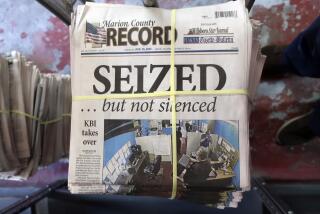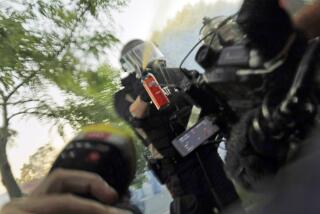Column: N. Dakota charges reporter with ‘riot’ for covering protest--but gets slapped down by judge
- Share via
Donald Trump’s increasingly febrile denunciations of the news media as part of a conspiracy to elect Hillary Clinton have garnered all the attention on the press freedom front, as is typical of his ranting.
But they shouldn’t distract from a genuine attack on the 1st Amendment waged by prosecutors in North Dakota. There, prosecutors threatened journalist Amy Goodman with a jail term and criminal fine for reporting on a public protest against an oil pipeline project.
[UPDATE: A state judge on Monday threw out the charge against Goodman, who tweeted after the ruling: “Vindication!”
[Following the ruling, Goodman told reporters on the scene, “This is a vindication for all journalists. We need to be able to report, and the state should not interfere….Today, the judge sided with freedom of the press and the 1st Amendment.”]
The charge stems from a Labor Day weekend confrontation in Morton County, outside of Bismarck, where several hundred Native Americans and others faced off against workers and security guards at the pipeline site. The $3.8-billion, 1,200-mile Dakota Access Pipeline is designed to carry oil from western North Dakota to a terminus in Illinois, crossing what the Standing Rock Sioux tribe says are ancestral lands and diving under the Missouri River, where fears are that a pipeline break could threaten the water supply.
What he’s doing is sending a message to all reporters: ‘Do not come to North Dakota.’
— Investigative reporter Amy Goodman, on being charged with participating in a riot by a North Dakota prosecutor
Goodman, host of the progressive radio and television news program Democracy Now!, was present Sept. 3, microphone in hand and cameras rolling, when the protest broke into a melee. Images from the scene show protesters entering a worksite where bulldozers were operating, a pipeline employee wrestling at least one protester to the ground, and protesters suffering from pepper spray and showing injuries from dog attacks.
Goodman interviewed numerous protestors, attempted to interview pipeline company employees, and assembled the footage into a video posted on the Democracy Now! website. (See below. Warning: The video contains profanity.) “We videoed a vicious attack on protesters,” she told me. “The pipeline security guards unleashed dogs and pepper spray on the Native Americans. We filmed a dog with blood dripping from his nose and his mouth.” The video, she says, “went viral,” with 14 million views and rebroadcasts on major cable network programs.
Five days later, local authorities charged her with criminal trespass.
The criminal complaint, as it happens, acknowledges that Goodman “can be seen on video identifying herself and interviewing protesters.”
Goodman was prepared on Monday to turn herself in to face the charge, when the prosecutors abruptly altered their strategy. They withdrew the trespassing complaint on Friday, apparently because they couldn’t establish that the tract Goodman entered had been posted as private property, and substituted a charge of participating in a “riot.” That charge carries a potential sentence of 30 days in jail and a $2,500 fine. As we write, Goodman says she hasn’t seen the criminal complaint. It’s before a state judge, who is scheduled to rule sometime Monday on whether it presents probable cause to proceed. If it comes to that, she’ll be pleading not guilty.
Whatever the charge, Goodman is correct in regarding it as an attempt to quash legitimate news reporting. Observing that State’s Atty. Ladd Erickson, who brought the charges, told the Bismarck Tribune that Goodman “put together a piece to influence the world on her agenda, basically. That’s fine, but it doesn’t immunize her from the laws of her state.”
Goodman observes in response: “We have a 1st Amendment. Is he saying that journalism is a crime? I think what he’s doing is sending a message to reporters: ‘Do not come to North Dakota.’”
The pipeline protest itself is no trivial event. The opponents have been fighting it in federal court for years, asserting that state and federal regulators haven’t met their duties to consult with local interests and weigh the potential environmental dangers before approving the right-of-way. They’ve consistently lost in court, most recently on Sept. 9, when a federal judge denied the Standing Rock tribe’s request for an injunction.
Almost immediately after the ruling, however, the Department of Justice, the Army Corps of Engineers and the Interior Department jointly announced that the Corps was temporarily halting work in the area of the Standing Rock protest “until it can determine whether it will need to reconsider any of its previous decisions.” Even more significantly, the agencies acknowledged that “this case has highlighted the need for a serious discussion on whether there should be nationwide reform with respect to considering tribes’ views on these types of infrastructure projects.”
The North Dakota prosecution is merely a new chapter in an old story: entrenched interests trying to stop public exposure of their activities, not uncommonly by labeling journalism as illegal or illegitimate. Sometimes this is done for spite, as when Silicon Valley billionaire Peter Thiel bankrolled the lawsuit launched by wrestler Hulk Hogan against the website Gawker. It was easy for the public to dismiss the episode as a case of just-desserts, since Gawker could be depicted as merely a celebrity-trolling website engaged in what seemed to be an invasion of privacy, even if its target was a public entertainer.
But that case is part of a continuum reaching its climax in Donald Trump’s outbursts. Trump began flaying the news media as soon as he realized that it was applying a critical eye on his candidacy rather than taking him at his own level of self-esteem. In recent days, he has stepped up the denunciations, depicting the media as colluding with the Clinton campaign and directing the rage of his rally audiences at the reporters in attendance.
This is despicable and dangerous, but it’s not qualitatively different from what prosecutor Erickson is trying: making the work of journalists seem something other than the search for facts in an effort to delegitimize what they discover. He certainly picked the wrong target. Goodman is the last journalist one would expect to back down. She’s also one of the most dedicated chroniclers of climate change policy we have.
In North Dakota, the effort may be backfiring, as often happens. The pipeline protests were hardly on the front burner of news media outside the northern prairie states — until a prosecutor charged a journalist with criminal activity for doing her job. Now a lot more people are watching.
Keep up to date with Michael Hiltzik. Follow @hiltzikm on Twitter, see his Facebook page, or email [email protected].
Return to Michael Hiltzik’s blog.
UPDATES:
11:47 a.m.: This post has been updated with a report from Goodman that a state judge rejected the “riot” charge against her.
More to Read
Sign up for Essential California
The most important California stories and recommendations in your inbox every morning.
You may occasionally receive promotional content from the Los Angeles Times.











